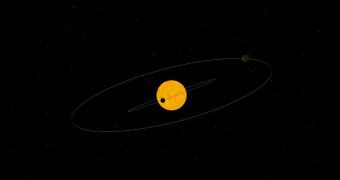An international collaboration of astronomers has recently determined that co-planar orbits, such as those occupied by planets in the solar system, are the norm throughout most planetary systems.
Planets occupying co-planar orbits spin in the same plane around their parent stars. This is interpreted as implying that all celestial bodies in each planetary system were formed from the same accretion disk, which existed around their respective stars when the latter were very young.
In our own solar system, the dwarf planet Pluto is an exception, since its path around the Sun takes it on a non-co-planar orbit with regards to the other planets. Other than this world, all planets in the solar system travel around the central star in the same plane.
In the new investigation, experts with the EXOEarths team at the Centro de Astrofísica da Universidade do Porto (CAUP), in Portugal, working closely with Swiss colleagues from the University of Geneva, determined that the majority of exoplanetary systems most likely respect this trend.
In order to reach this conclusion, the researchers used data from the High Accuracy Radial Velocity Planet Searcher (HARPS) spectrograph on the European Southern Observatory's (ESO) 3.6-meter telescope at La Silla, Chile, and the NASA Kepler Telescope.
One of the main implications the new study has is that if confirms an older theory, which suggests that planetary collisions inside the same system are very rare. It also shows that, in the most extreme cases, deviations from the plane reach a maximum of 5 degree in either direction.
The findings provide solid scientific evidence that planets indeed form from protoplanetary disks around their parent stars. These disks are made up of material that previously existed in the molecular cloud from which the star collapsed.
What is left behind tends to accumulate around the newly-formed star, and to form a ring-like structure. In time, condensation nuclei made from chemical elements heavier than hydrogen and helium appear and matter begins to clump up around them.
Naturally, the emerging structures – called planetesimals (planetary embryos) – move around their parent stars in the same plane, since they all came from the same disk, AlphaGalileo reports.
“These results show us that the way our Solar System formed must be common. Its structure is the same as the other planetary systems we studied, with all planens orbiting roughly in the same plain,” CAUP investigator Pedro Figueira explains.

 14 DAY TRIAL //
14 DAY TRIAL //